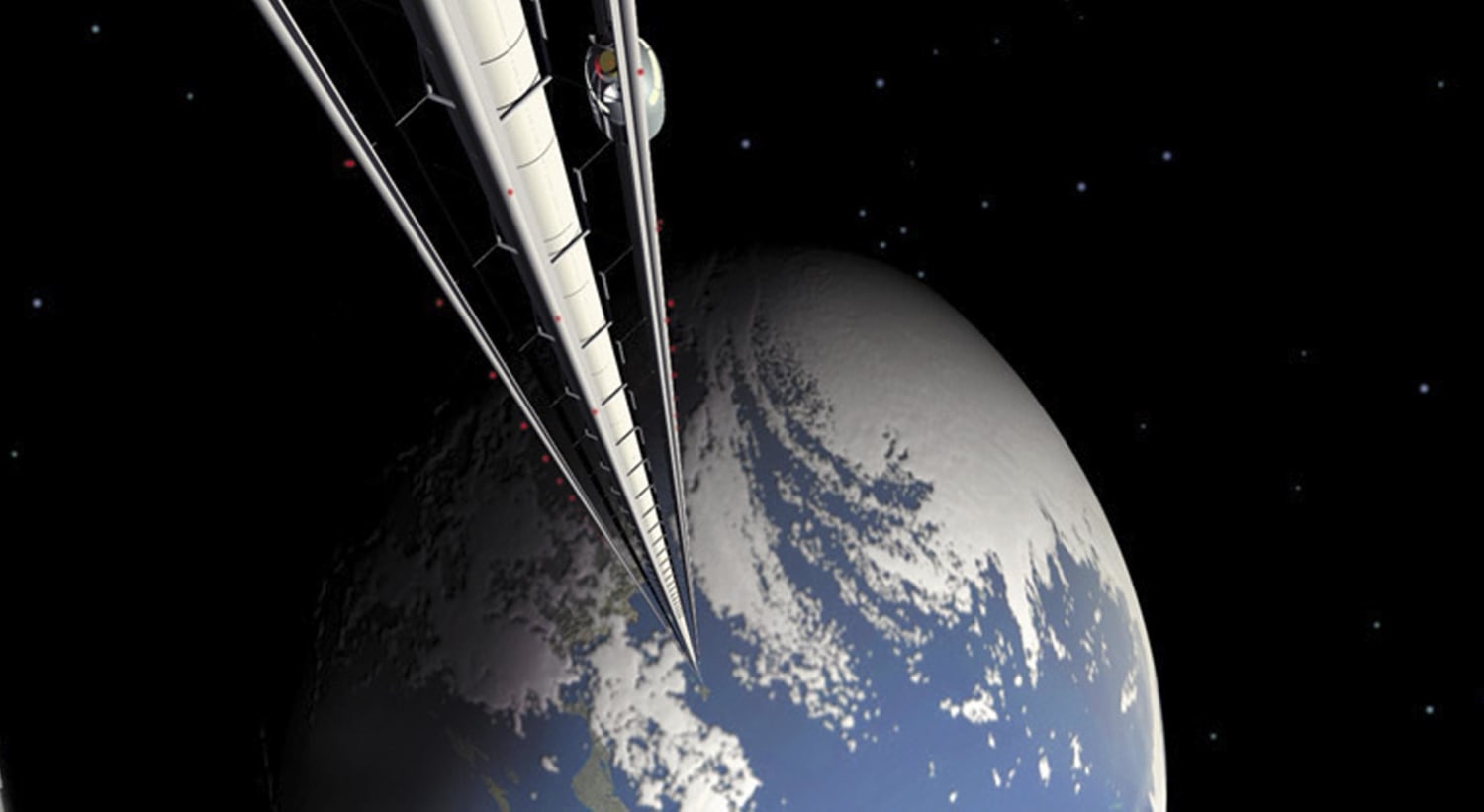 |
| Image from TechInsider. |
Getting To Space Is Cheaper Than You Think
 |
| Probably not this cheap though. |
Well, the 100 kWh is the theoretical minimum you need to overcome gravity. Any launch system is going to be less than 100% efficient, so you'll always need to put in more energy than that. Rockets in particular have to carry all their own fuel, and the fuel is heavy, so they need to carry enough to lift both the weight of the fuel and the payload. And merely reaching 100 km altitude is far easier than going into orbit at 100 km altitude.
To hurl something up to 100 km altitude, you'd have to give it a staring speed of about 1.4 km/s (3,100 mph), ignoring air resistance. But if you did that, it would simply go straight up and then fall straight back down again.
 |
| More on this at the excellent xkcd. |
 |
| Or you can just troll physics. |
 |
| Maybe. Maybe not. |
Space Elevators
 |
| Source. |
Here's the thing. The station at the end of the tether is in orbit, just like any other satellite. "Drop" something from the end station and it won't fall, because it's already in orbit. At lower levels, this isn't true. The tension in the tether forces it to stay up, but the speed of the tether at all points below the station isn't high enough for it to be orbiting. So if something fell off from halfway up, it would simply drop to the Earth below.
| Source. |
All of which means that, unlike falling off a cliff, if you fell off a space elevator from a high enough altitude you'd actually move forwards relative to it. And if you were high enough up, you wouldn't hit the ground at all - you'd go into orbit. Not a nice circular obit like at the top of the tether, but a hair-raising elliptical orbit (which in the example shown here would probably graze the atmosphere so you'd die a horrible fiery death).
 |
| Note that all the little spheres drop at the same time. But gravity is so much weaker at the top that it takes them much longer to fall. The Python code used to generate this is available here. |
What About Thor ?
He isn't relevant at all. Check your spelling.
Err, OK, what about Thoth ?
I'm so very glad you asked. Thoth's design is completely different. At just 20 km tall, it's not something most people would recognize as space elevator - more of a conventional building. The thing is, 20 km just isn't high enough to convey any advantage whatsoever. At that height gravity is only about 1% less than at sea level. You need to go to altitudes of thousands of kilometres before gravity really drops significantly. Here are some numbers in handy gif form, because maths.
 |
| 1 g is the gravity we experience : 9.81 m/s/s. The times shown are how long it would take to fall 1 metre under those accelerations, at the altitudes shown at the top. Earth's gravity at 5,000 km is roughly the same as the surface gravity of Mars, while at 10,000 km it's about the same as on the Moon. Yes, I know this isn't my most sophisticated graphic, but my computer is dying. Gotta keep it simple. |
Oh, really ?Finally, Quine claims that since rockets eat up about 30% of their fuel during the first 12-mile ascent, the tower will offer the same savings in fuel compared to conventional rockets launched from the ground.
I think not. Rockets use more of their fuel in the early stages because that's just how rockets work. The initial mass of the rocket is very large. So if you want to accelerate that large mass against gravity, you have to eject a correspondingly large mass out the other end. Moving the rocket 20 km up makes absolutely no difference to the size of the rocket needed whatsoever, if you still want to reach the same final speed with the same payload with the same gravity.
There's one possible escape for Thoth : the tower would be so tall it would be above quite a lot of the atmosphere. At 20 km the atmosphere is about 13 times less dense than at sea level. Except there's just no way that's going to save you anything like 30%, as this NASA engineer describes, and this helpful random person on the internet explains using maths. Atmospheric drag accounts for slowing the rocket by maybe a few tens of metres per second, compared to the required velocity of several thousands of metres per second. Basically, no.
But Thoth have compounded error upon error. Even if their 30% figure was correct, it's dubious if it would help. It would be like having a 30%-off sale at Harrods : the wealthy are so rich they won't care, and the rest of us still couldn't afford it.
OK, so it would help for those people in the narrow band for whom a space mission was just about out of reach. But the cost of the tower is claimed by Thoth as $5 billion, and others at more like $500 billion, as well as the engineering challenges of its construction being formidable to say the least. So it's a case of one of the most stupendous engineering projects in history for the sake of saving 30% on very expensive rocket launches. Doesn't seem like a great deal to me - and remember, that 30% saving looks wildly optimistic.
Thoth's plan for how the tower would be used looks even worse :
"Astronauts would ascend to 20 km by electrical elevator. From the top of the tower, space planes will launch in a single stage to orbit, returning to the top of the tower for refueling and reflight,” said Dr. Brendan Quine, the inventor.Righto, first off - when did "inventor" start to mean, "someone who had an idea" ? I've got this idea for a genetically engineered fire-breathing horse that can ride a unicycle - if I patent it do I get to call myself an inventor ? How about a robot that can procrastinate ? Some sort of swimming couch... ?
 |
| THEY SAID I WAS MAD !!!! |
* If it wasn't already clear : being 20 km further up doesn't make it any easier to develop a single-stage-to-orbit vehicle.
 |
| All I'm saying is that no-one with an ounce of sense will put a shred of money into this. |
So as far as I can tell, Thoth's plan relies on some absurdly fundamental misunderstandings of high school physics. It just won't work.
Bur let's end on a positive note. Private companies have been making ludicrous proposals for decades - Thoth's is nothing new. The difference now is that these absurdities notwithstanding, private space ventures are finally starting to make a difference. Space tourism is a reality - albeit only for the super-rich, but with the prospect of a dramatic price fall no longer a pipe dream. Space X and Orbital Sciences (now known by the less inspiring name of Orbital ATK) have already delivered cargo to the International Space Station, while Scaled Composites claimed the first astronaut launched by a privately-built rocket. And let's not forget : though Thoth's idea is very silly, someday a proper space elevator might really open up the road to the stars.






*IF* Thoth's inflatable-tower construction technology actually works (does it?), then one thing that a twenty-kilometer-high tower *might* be good for could be as part of the support structure for a much longer catapult/mass driver to put objects into orbit. Launch your spacecraft from the ground, use an electric railgun/maglev thingie to accelerate it up an incline for 50 km or so, and part company from the top of the structure 20 km up moving at a substantial fraction of orbital velocity in more-or-less the right direction.
ReplyDeleteThis would, of course, be a far larger and more expensive undertaking than Thoth's elevator, but it would be far more useful. And it would have several advantages over an "orbital tower" space elevator: it would be immune to the orbital debris problem, it would be easier to build, it wouldn't have to be on the Earth's equator, it doesn't need to be constructed of handwavium or unobtainium, it wouldn't be subject to odd vibrational modes, and it wouldn't be eroded by atomic oxygen.
That's assuming Thoth's inflatable technology does work, whatever it is. Would their inflatable tower be subject to 1/e scale height pressure constraints?
Eh. I don't expect anyone to be fool enough to try to build either of these.
By the way, I've been reading your blog for several months and greatly enjoy it. Please keep it going!
I did wonder about something like that. I was thinking a spiral, low-pressure railgun/hyperloop-style dealy winding around the tower... basically a 12 mile-high cannon. It sounds better than launching rockets off the top and landing them back there again. You probably couldn't make magnets light enough for this to work though.
DeleteI have serious doubts that the inflatable technology will work (see Tech Insider and links therein), but I'm not an engineer. Happy to be proved wrong, assuming some crazy billionaire gives them the money for their 1.5 km prototype.